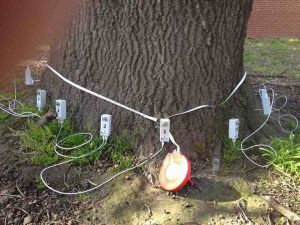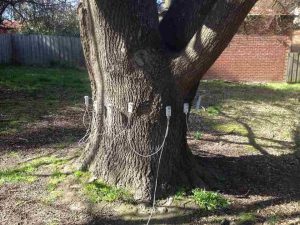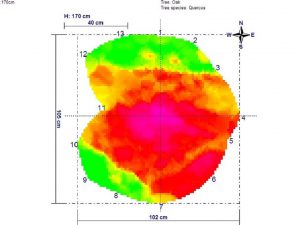Picus Tomograph
Picus Tomograph - Tree Decay
We used a Picus Tomograph to detect tree decay in this tree meaning we could remove this tree as it was a hazardous tree.
In the previous Tree Case – Tree Report Old Oak – the local council rejected an application to remove this dangerous tree although our Arborist report stated …
“This large old Oak has a structural defect running through the centre of its trunk from the main fork structure approximately 1.2 to 2 metres above ground down both its western and eastern sides and therefore the concern is this tree may split through its centre. It also has another crack on it north eastern side.”
We provided plenty of photographic evidence to prove our case this was a dangerous tree but council persisted and among other things said …
“The White Oak Quercus lobata is a healthy canopy tree that adds significantly to the amenity of the area.”
“The Quercus lobata is a unique specimen tree of exceptional size, age and health.”
Being quite certain this old Oak was full of decay to its base because of the signs it showed we suggested to the client a way to prove that it was a dangerous tree may be to use an Arbotom which similar to a Picus Tomograph is an advanced tool that uses sound impulses sent through a series of sensors attached to the tree’s trunk and monitored through a computer where the data is collected.
Stress waves travel through sound wood faster than through damaged wood. Sensors around the tree measure the time it takes an impulse to travel through the wood and reach the other sensors. The collected data is simultaneously sent to a computer which will turn the data into a coloured image of the tree’s cross-section.
The colour chart below shows colours from left to right; green – solid wood; yellow through to orange – less dense wood or decaying wood and red through to purple – very probably or certainly decayed wood.

If you click on the images below you can see the four “slices” we took through the trees trunk- above ground level.
One at 10 cm, the next 70 cm followed by 140 cm and 170 cm up the trunk.
From looking at the images it was obvious this tree was literally full of decay and with such a wide spreading canopy really dangerous and therefore was removed.
We submitted our findings to council and my client received a phone call from them telling him to remove the tree immediately as it was hazardous.
Interestingly as our client told me; the council officer also asked if he would mind if they used our Arborist Report as an aid to help train their arborists.
If you have an issue with a tree and would like it looked at or assessed please get in contact by using the form to the right above.








